Early Permian Granitic Magmatism in Middle Part of the Northern Margin of the North China Craton: Petrogenesis, Source, and Tectonic Setting
Abstract
:1. Introduction
2. Geologic Background and Petrography
2.1. Geologic Setting
2.2. Petrography
3. Methods
3.1. Whole-Rock Analysis
3.2. Zircon Analyses
3.2.1. SHRIMP Zircon Analyses
3.2.2. LA-ICP-MS Zircon Analyses
4. Results
4.1. Zircon U-Pb Geochronology
4.1.1. Alkali-Feldspar Granites
4.1.2. Granites
4.1.3. Diorite and Syenodiorite
4.2. Major and Trace Element Contents
4.3. Sr-Nd-Pb Isotopic Compositions
4.4. Zircon Hf Isotopic Compositions
5. Discussion
5.1. Rock Classification
5.1.1. Alkali-Feldspar Granites
5.1.2. Granites
5.2. Petrogenesis and Magma Sources
5.2.1. Alkali-Feldspar Granites
5.2.2. Granites
5.2.3. Diorite and Syenodiorite
5.3. Tectonic Implications
6. Conclusions
Supplementary Materials
Author Contributions
Funding
Institutional Review Board Statement
Informed Consent Statement
Data Availability Statement
Acknowledgments
Conflicts of Interest
References
- Windley, B.F.; Alexeiev, D.; Xiao, W.; Kröner, A.; Badarch, G. Tectonic models for accretion of the Central Asian Orogenic Belt. J. Geol. Soc. 2007, 164, 31–47. [Google Scholar] [CrossRef] [Green Version]
- Yue, Y.; Liou, J.G.; Graham, S.A. Tectonic correlation of Beishan and Inner Mongolia orogens and its im-plications for the palinspastic reconstruction of north China. Mem. Geol. Soc. Am. 2001, 194, 101–116. [Google Scholar]
- Xu, B.; Chen, B. The structure and evolution of the Middle Paleozoic orogenic belt between the North China plate and the Siberia plate in northern Inner Mongolia. Sci. China Ser. D 1997, 27, 227–232. (In Chinese) [Google Scholar]
- Xiao, W.J.; Windley, B.F.; Hao, J.; Zhai, M. Accretion leading to collision and the Permian Solonker suture, Inner Mongolia, China: Termination of the central Asian orogenic belt. Tectonics 2003, 22, 1–20. [Google Scholar] [CrossRef] [Green Version]
- Xiao, W.; Windley, B.F.; Huang, B.C.; Han, C.M.; Yuan, C.; Chen, H.L.; Sun, M.; Sun, S.; Li, J.L. End-Permian to mid-Triassic termination of the accretionary processes of the southern Altaids: Implications for the geodynamic evolution, Phanerozoic continental growth, and metallogeny of Central Asia. Int. J. Earth Sci. 2009, 98, 1189–1217. [Google Scholar] [CrossRef]
- Jian, P.; Liu, D.; Kröner, A.; Windley, B.F.; Shi, Y.; Zhang, W.; Zhang, F.Q.; Miao, L.C.; Zhang, L.Q.; Tomurhuu, D. Evolution of a Permian intraoceanic arc–trench system in the Solonker suture zone, Central Asian Orogenic Belt, China and Mongolia. Lithos 2010, 118, 169–190. [Google Scholar] [CrossRef]
- Zhang, S.-H.; Zhao, Y.; Song, B.; Hu, J.; Liu, S.-W.; Yang, Y.-H.; Chen, F.-K.; Liu, X.-M.; Liu, J. Contrasting Late Carboniferous and Late Permian-Middle Triassic intrusive suites from the northern margin of the North China craton: Geochronology, petrogenesis, and tectonic implications. Geol. Soc. Am. Bull. 2009, 121, 181–200. [Google Scholar] [CrossRef]
- Wang, Y.Y.; Xu, B.; Cheng, S.D.; Liao Shao, W.J.; Wang, Y. Zircon U-Pb dating of the mafic lava from Wudaoshimen, Hexigten, Inner Mongolia and its geological significance. Acta Petrol. Sin. 2014, 30, 2055–2062. (In Chinese) [Google Scholar]
- Wang, A.; Liu, Y. Neoarchean (2.5–2.8 Ga) crustal growth of the North China Craton revealed by zircon Hf isotope: Asynthesis. Geosci. Front. 2012, 3, 147–173. (In Chinese) [Google Scholar] [CrossRef] [Green Version]
- Wang, W.Q. Late-Paleozoic Tectonic Evolution of the Central-Northern Margin of the North China Craton: Constraints from Zircon U-Pb Ages and Geochemistry of Igneous Rocks in Ondor Sum-Jining Area. Ph.D. Thesis, Jilin University, Jilin, China, 31 May 2014. (In Chinese). [Google Scholar]
- Zhang, S.-H.; Zhao, Y.; Liu, X.-C.; Liu, D.-Y.; Chen, F.K.; Xie, L.-W.; Chen, H.-H. Late Paleozoic to Early Mesozoic mafic–ultramafic complexes from the northern North China Block: Constraints on the composition and evolution of the lithospheric mantle. Lithos 2009, 110, 229–246. [Google Scholar] [CrossRef]
- Zhang, S.-H.; Zhao, Y.; Kröner, A.; Liu, X.-M.; Xie, L.-W.; Chen, F.-K. Early Permian plutons from the northern North China Block: Constraints on continental arc evolution and convergent margin magmatism related to the Central Asian Orogenic Belt. Int. J. Earth Sci. 2009, 98, 1441–1467. [Google Scholar] [CrossRef]
- Shao, J.A.; He, G.Q.; Tang, K.D. The evolution of Permian continental crust in northern part of North China. Acta Petrol. Sin. 2015, 31, 47–55. (In Chinese) [Google Scholar]
- Luo, H.L.; Wu, T.R.; Zhao, L. Zircon SHRIMP U-Pb dating Wuliangsitai A-type granite on the northern margin of the North China Plate and tectonic significance. Acta Petrol. Sin. 2009, 25, 515–526. [Google Scholar]
- Jian, P.; Zheng, J.; Griffin, W.L.; O’Reilly, S.Y.; Lu, F.; Wang, C.; Zhang, M.; Wang, F.Z.; Li, H.M. 3.6 Ga lower crust in central China: New evidence on the assembly of the North China craton. Geology 2004, 32, 229–232. [Google Scholar] [CrossRef]
- Jiang, N.; Guo, J.H.; Zhai, M.G.; Zhang, S.Q. ∼2.7 Ga crust growth in the North China craton. Precambrian Res. 2010, 179, 37–49. [Google Scholar] [CrossRef]
- Wang, H.C.; Zhao, F.Q.; Li, H.M.; Sun, L.X.; Miao, L.C.; Ji, S.P. Zircon SHRIMP U-Pb age of the dioritic rocks from northern Hebei: The geological records of late Paleozoic magmatic arc. Acta Petrol. Sin. 2007, 23, 597–604. (In Chinese) [Google Scholar]
- Zhang, S.-H.; Zhao, Y.; Song, B.; Yang, Z.-Y.; Hu, J.-M.; Wu, H.C. Carboniferous granitic plutons from the northern margin of the North China block: Implications for a late Palaeozoic active continental margin. J. Geol. Soc. 2007, 164, 451–463. [Google Scholar] [CrossRef]
- Wang, X.L. Research of Dengshenmiao Granitoids of Permian. Master’s Thesis, Peking University, Beijing, China, 14 June 2007. (In Chinese). [Google Scholar]
- Zhang, Y.Q. The Geochemistry and Tectonic Significance of Granitioid-Dioritoid Rocks in the Western of Langshan Mt., Inner Mongolia. Master’sThesis, Lanzhou University, Lanzhou, China, 18 June 2012. (In Chinese). [Google Scholar]
- Luo, H.L. On the Permian Magmatism of the Middle Segment of the Northern Margin of the North China Plate and Its Tectonic Implication. Ph.D. Thesis, Peking University, Beijing, China, May 2007. (In Chinese). [Google Scholar]
- Ling, M.X.; Zhang, H.; Li, H.; Liu, Y.L.; Liu, J.; Li, L.Q.; Li, C.Y.; Yang, X.Y.; Sun, W.D. The Permian-Triassic granitoids in Bayan Obo, North China Craton: A geochemical and geochronological study. Lithos 2014, 190–191, 430–439. [Google Scholar] [CrossRef]
- Zeng, J.J.; Zheng, Y.Y.; Qi, J.H.; Dai, F.H.; Zhang, G.Y.; Pang, Y.C.; Wu, B. Foundation and geological significance of Adakitic Granite at Guyang of Inner Mongolia. Earth Sci. 2008, 33, 755–763. (In Chinese) [Google Scholar]
- Yuan, G.B.; Wang, H.C. Magmatic Activity and It’s Tectonic Implications During the Early Permian in the Northwestward of Wuchuan, Inner Mongolia. Geol. Survey Res. 2006, 29, 302–310. (In Chinese) [Google Scholar]
- Zhang, Y.Q.; He, Z.Y.; Zhang, J.; Chen, S.H. Discussion on tectonic Setting of the quartz diorite in Shilanhada, northern Daqingshan Mountain in Inner Mongolia. Geol. Survey Res. 2007, 3, 22–26. (In Chinese) [Google Scholar]
- Feng, L.X.; Zhang, Z.C.; Han, B.F.; Ren, R.; Li, J.F.; Su, L. LA-ICP-MS zircon U-Pb ages of granitoids in Darhan Muminggan Joint Banner, Inner Mongolia, and their geological significance. Geol. Bull. China 2013, 32, 1737–1748. (In Chinese) [Google Scholar]
- Zhao, Q.Y.; Liu, Z.H.; Wu, X.W.; Chen, X.F. Characteristics and origin of Halaheshao pluton in Daqingshan region, Inner Mongolia. J. Mineral. Petrol. 2007, 27, 46–51. (In Chinese) [Google Scholar]
- Liu, C.F.; Liu, W.C.; Zhou, G.Z. Geochronology, geochemistry and tectonic setting of the Paleozoic Early Mesozoic intrusive in Siziwangqi, Inner Mongolia. Acta Petrol. Sin. 2014, 88, 992–1002. (In Chinese) [Google Scholar]
- Zhang, Y.M.; Zhang, H.F.; Zhou, Z.G.; Liu, W.C. Genetic and Tectonics significance of the Damiao granodiorite, Siziwangqi, Inner Mongolia. J. Mineral. Petrol. 2008, 28, 28–38. (In Chinese) [Google Scholar]
- Li, L.Y. Geological characteristics and tectonic significance of Gonghuduge granite rock body in Siz-iwangqi, Inner Mongolia. Geol. Resour. 2005, 14, 97–102. (In Chinese) [Google Scholar]
- Liu, C.F.; Zhou, G.Z.; Zhang, H.F.; Liu, W.C.; Zhang, L. Petrochemical characteristics and timing of Wuertagaolemiao granitoids, Siziwangqi, Inner Mongolia. J. Mineral. Petrol. 2011, 31, 34–43. (In Chinese) [Google Scholar]
- Feng, F.; Xu, Z.Y.; Dong, X.J.; Shi, Q.; Wang, S.J.; Li, C.H. LA-ICP-MS Zircon U-Pb dating, Hf isotopic compositions of granite porphyry in Wenduermiao-Jining Arae, Inner Mongolia and its geological significance. Earth Sci. 2020. accepted. (In Chinese) [Google Scholar]
- Wang, W.Q.; Xu, Z.Y.; Liu, Z.H.; Zhao, Q.Y.; Jiang, X.J. Early Middle Permian tectonic evolution of the Central-Northern margin of the North China Craton: Constraints from zircon U-Pb ages and geochemistry of the granitoids. Acta Petrol. Sin. 2013, 29, 2987–3003. (In Chinese) [Google Scholar]
- Hong, D.; Wang, T.; Tong, Y. An outline about granitoids in china. Geol. Rev. 2007, 53, 9–16. (In Chinese) [Google Scholar]
- Jiang, X.J. Characteristics of Middle Permian Granitoids in Jining, Inner Mongolia and Their Geological Significance. Master’sThesis, Jilin University, Changchun, China, 10 June 2014. (In Chinese). [Google Scholar]
- Wang, S.J.; Xu, Z.Y.; Dong, X.J.; Wang, W.Q.; Li, P.C. Geochemical characteristics and zircon U-Pb age of the granodiorite-norite gabbro in the northern margin of the North China Block and their formation mechanism. Earth Sci. 2018, 43, 3267–3284. (In Chinese) [Google Scholar]
- Peng, Y.B.; Jiang, X.J.; Yan, P.B.; Dai, M.J.; Xing, Y.J. LA-ICP-MS zircon-Pb ages, geochemical characteristics of middle Permian Qianhuhetaolegai granite in Zhengxiangbaibanner, Inner Mongolia and their tectonic significances. Geol. Rev. 2018, 64, 1379–1392. (In Chinese) [Google Scholar]
- Xia, Y.J.; Wu, Q.H.; Xi, X.S. Zircon geochronology and trace Element characteristics of the Woniushan granites in Taibus Banner, Inner Mongolia, and their geological significance. Geol. Bull. China 2016, 35, 943–952. (In Chinese) [Google Scholar]
- Zhang, S.H. The Late Paleozoic Early Mesozoic Tectonomagmatie Activities in the Eastern Segment of the Inner Mongolian Uplift in the Yanshan Tectonic Belt and Their Geological Significance. Ph.D. Thesis, Chinese Academy of Geological Sciences, Beijing, China, 8 June 2004. (In Chinese). [Google Scholar]
- Zhang, X.H.; Zhai, M.G. Magmatism and its metallogenetic effects during the Paleozoic continental crustal construction in northern North China: An overview. Acta Petrol. Sin. 2010, 26, 1329–1341. (In Chinese) [Google Scholar]
- Hua, B.; Gao, X.; Hu, Z.G.; Mei, Z.H.; Zhang, Z.W.; Meng, Y.S.; Zhang, B.T.; Zhao, L. Petrogenesis and tectonic setting of the Wuzhuxinwusu granite, western Xing-Meng Orogenic Belt: Evidences from geochemistry, zircon U-Pb geochronology and Sr-Nd-Hf isotopes. Acta Petrol. Sin. 2020, 36, 1426–1444. (In Chinese) [Google Scholar]
- Norrish, K.; Chappell, B.W. X-ray fluorescence spectrometry. In Physical Methods in Determinative Mineralogy; Zussman, J., Ed.; Academic Press: London, UK, 1977; pp. 201–272. [Google Scholar]
- Govindaraju, K. Compilation of working values and sample description for 383 standards. Geostand. Geoanal. Res. 1994, 18, 1–158. [Google Scholar] [CrossRef]
- Steiger, R.H.; Jäger, E. Subcommission on geochronology: Convention on the use of decay constants in geo- and cosmochronology. Earth Planet. Sci. Lett. 1977, 36, 359–362. [Google Scholar] [CrossRef]
- Lugmair, G.W.; Marti, K. Lunar initial 143Nd/144Nd: Differential evolution of the lunar crust and mantle. Earth Planet. Sci. Lett. 1978, 39, 3349–3357. [Google Scholar] [CrossRef]
- Black, L.P.; Kamo, S.L.; Allen, C.M.; Aleinikoff, J.N.; Davis, D.W.; Korsch, R.J.; Foudoulis, C. TEMORA 1: A new zircon standard for Phanerozoic U–Pb geochronology. Chem. Geol. 2003, 200, 155–170. [Google Scholar] [CrossRef]
- Williams, I.S.; Buick, I.S.; Cartwright, I. An extended episode of early Mesoproterozoic metamorphic fluid flow in the Reynolds Range, central Australia. J. Metamorph. Geol. 1996, 14, 29–47. [Google Scholar] [CrossRef]
- Wiedenbeck, M.; Allé, P.; Corfu, F.; Griffin, W.; Meier, M.; Oberli, F.; Von Quadt, A.; Roddick, J.; Spiegel, W. three natural zircon standards for U-Th-Pb, Lu-Hf, trace element and REE Analyses. Geostand. Geoanalytical Res. 1995, 19, 1–23. [Google Scholar] [CrossRef]
- Yuan, H.L.; Gao, S.; Dai, M.N.; Zong, C.L.; Günther, D.; Fontaine, G.H.; Liu, X.M.; Diwu, C.R. Simultaneous determinations of U-Pb age, Hf isotopes and trace element compositions of zircon by excimer la-ser-ablation quadrupole and multiple-collector ICP-MS. Chem. Geol. 2008, 247, 100–118. [Google Scholar] [CrossRef]
- Liu, S.; Hu, R.; Gao, S.; Feng, C.; Feng, G.; Coulson, I.M.; Li, C.; Wang, T.; Qi, Y. Zircon U–Pb age and Sr–Nd–Hf isotope geochemistry of Permian granodiorite and associated gabbro in the Songliao Block, NE China and implications for growth of juvenile crust. Lithos 2010, 114, 423–436. [Google Scholar] [CrossRef]
- Hou, K.J.; Li, Y.H.; Xie, G.Q. Laser Ablation-ICP-MS technique for Hf isotope microanalysis of zircon and its geological applications. Acta Petrol. Sin. 2007, 23, 2595–2604. (In Chinese) [Google Scholar]
- Scherer, E.; Münker, C.; Mezger, K. Calibration of the Lutetium-Hafnium Clock. Science 2001, 293, 683–687. [Google Scholar] [CrossRef] [PubMed]
- Blichert-Toft, J.; Chauvel, C.; Albarède, F. Separation of Hf and Lu for high-precision isotope analysis of rock samples by magnetic sector-multiple collector ICP-MS. Contrib. Miner. Pet. 1997, 127, 248–260. [Google Scholar] [CrossRef]
- Griffin, W.L.; Pearson, N.J.; Belousova, E.; Jackson, S.E.; van Achterbergh, E.; O’Reilly, S.Y.; Shee, S.R. The Hf isotope composition of cratonic mantle: LAM-MC-ICPMS analysis of zircon megacrysts in kimberlites. Geochim. Cosmochim. Ac. 2000, 64, 133–147. [Google Scholar] [CrossRef]
- Griffin, W.L.; Wang, X.; Jackson, S.E.; Pearson, N.J.; O’Reilly, S.Y.; Xu, X.; Zhou, X. Zircon chemistry and magma mixing, SE China: In-Situ analysis of Hf isotopes, Tonglu and Pingtan igneous complexes. Lithos 2002, 61, 237–269. [Google Scholar] [CrossRef]
- Black, L.P.; Jagodzinski, E.A. Importance of establishing sources of uncertainty for the derivation of reliable SHRIMP ages. Aust. J. Earth Sci. 2003, 50, 503–512. [Google Scholar] [CrossRef]
- Geng, Y.S.; Shen, Q.H.; Ren, L.D. Late Neoarchean to Early Paleoproterozoic magmatic events and tec-tonothermal systems in the North China Craton. Acta Petrol. Sin. 2010, 26, 1945–1966. (In Chinese) [Google Scholar]
- Sun, S.-S.; McDonough, W.F. Chemical and isotopic systematics of oceanic basalts: Implications for mantle composition and processes. Geol. Soc. Lond. Spec. Publ. 1989, 42, 313–345. [Google Scholar] [CrossRef]
- Han, B.F.; Zhang, L.; Wang, Y.M.; Song, B. Enriched mantle source for Palcoproterozoic high Mg and low Ti-P mafic dykes in central part of the North China craton: Constraints from zircon Hf isotopic composi-tions. Acta Petrol. Sin. 2007, 23, 277–284. (In Chinese) [Google Scholar]
- Liu, J.H.; Liu, F.L.; Ding, Z.J.; Liu, P.H.; Wang, F.; You, J.J. The zircon Hf isotope characteristics of~2.5Ga magmatic event, and implication for the crustal evolution in the Jiaobei terrane, China. Acta Petrol. Sin. 2012, 28, 2697–2704. (In Chinese) [Google Scholar]
- Xia, X.; Sun, M.; Zhao, G.; Luo, Y. LA-ICP-MS U–Pb geochronology of detrital zircons from the Jining Complex, North China Craton and its tectonic significance. Precambrian Res. 2006, 144, 199–212. [Google Scholar] [CrossRef] [Green Version]
- Collins, W.J.; Beams, S.D.; White, A.J.R.; Chappell, B.W. Nature and origin of A-type granites with par-ticular reference to southeastern Australia. Contrib. Mineral. Petr. 1982, 80, 189–200. [Google Scholar] [CrossRef]
- Whalen, J.B.; Currie, K.L.; Chappell, B.W. A-type granites: Geochemical characteristics, discrimination and petrogenesis. Contrib. Miner. Pet. 1987, 95, 407–419. [Google Scholar] [CrossRef]
- Zhang, X.; Wei, R.; Xu, S.; Lei, S. Zircon U-Pb geochronology, geochemistry and petrogenesis of the Permian A--type granite in the Honggeer area, central Inner Mongolia. Geochimica 2017, 46, 511–527. (In Chinese) [Google Scholar]
- Wu, F.-Y.; Liu, X.; Ji, W.; Wang, J.; Yang, L. Highly fractionated granites: Recognition and research. Sci. China Earth Sci. 2017, 60, 1201–1219. (In Chinese) [Google Scholar] [CrossRef]
- Breiter, K.; Lamarão, C.N.; Borges, R.M.K.; Dall’Agnol, R. Chemical characteristics of zircon from A-type granites and comparison to zircon of S-type granites. Lithos 2014, 192–195, 208–225. [Google Scholar] [CrossRef]
- Eby, G.N. Chemical subdivision of the A-type granitoids:Petrogenetic and tectonic implications. Geology 1992, 20, 641–654. [Google Scholar] [CrossRef]
- Chappell, B.W. Aluminium saturation in I- and S-type granites and the characterization of fractionated haplogranites. Lithos 1999, 46, 535–551. [Google Scholar] [CrossRef]
- Creaser, R.A.; Price, R.C.; Wormald, R.J. A-type granites revisited: Assessment of a residual-source model. Geology 1991, 19, 163–166. [Google Scholar] [CrossRef]
- Patiño Douce, A.E. What do experiments tell us about the relative contributions of crust and mantle to the origin of granitic magmas? Geol. Soc. Lond. Spec. Publ. 1999, 168, 55–75. [Google Scholar] [CrossRef]
- Skjerlie, K.P.; Johnston, A.D. Fluid-Absent Melting Behavior of an F-Rich Tonalitic Gneiss at Mid-Crustal Pressures: Implications for the Generation of Anorogenic Granites. J. Pet. 1993, 34, 785–815. [Google Scholar] [CrossRef]
- Bonin, B. Do coeval mafic and felsic magmas in post-collisional to within-plate regimes necessarily imply two contrasting, mantle and crustal, sources? A review. Lithos 2004, 78, 1–24. [Google Scholar] [CrossRef]
- Turner, S.P.; Foden, J.D.; Morrison, R.S. Derivation of some A-type magmas by fractionation of basaltic magma: An example from the Padthaway Ridge, South Australia. Lithos 1992, 28, 151–179. [Google Scholar] [CrossRef]
- Wu, Q.; Niu, M.L.; Zhu, G.; Wang, T.; Fei, L.L. Zircon U-Pb age, petrogenesis of the Changgang A-type granites in the Lujiang segment of the Tan-Lu fault zone and their implication. Acta Petrol. Sin. 2016, 32, 1031–1048. (In Chinese) [Google Scholar]
- King, P.L.; White, A.J.R.; Chappell, B.W.; Allen, C.M. Characterization and origin of aluminous A—type granites from the Lachlan Fold Belt, Southeastern Australia. J. Petrol. 1997, 38, 371–391. [Google Scholar] [CrossRef]
- Wu, F.Y.; Li, X.H.; Yang, J.H.; Zheng, Y.F. Discussions on the petrogenesis of granites. Acta Petrol. Sin. 2007, 23, 1217–1238. (In Chinese) [Google Scholar]
- Wu, F.Y.; Sun, D.Y.; Li, H.; Jahn, B.M.; Wilde, S. A-type granites in northeastern China: Age and geo-chemical constraints on their petrogenesis. Chem. Geol. 2002, 187, 143–173. [Google Scholar] [CrossRef]
- Jiang, N.; Guo, J.; Chang, G. Nature and evolution of the lower crust in the eastern North China craton: A review. Earth-Science Rev. 2013, 122, 1–9. [Google Scholar] [CrossRef]
- Clemens, J.D.; Stevens, G. What controls chemical variation in granitic magmas? Lithos 2012, 134–135, 317–329. [Google Scholar] [CrossRef]
- Deng, J.F.; Wu, Z.X.; Zhao, G.C.; Zhao, H.L.; Luo, Z.H.; Mo, X.X. Precambrian granite rocks, continental crust evolution and craton formation of the North China Platform. Acta Petrol. Sin. 1999, 15, 190–198. (In Chinese) [Google Scholar]
- Roberts, M.P.; Clemens, J.D. Origin of high-potassium, calc-alkaline, I-type granitoids. Geology 1993, 21, 825–828. [Google Scholar] [CrossRef]
- Sun, D.Y.; Wu, F.Y.; Zhang, Y.B.; Gao, S. The final closing time of the west Lamulun Riv-er-Changchun-Yanji plate suture zone: Evidence from the Dayushan granitic pluton, Jilin Province. J. Jilin Univ. 2004, 34, 174–181. (In Chinese) [Google Scholar]
- Green, J.C. Volcanic rocks of the Midcontinent Rift System: A review. In Basement Tectonics 10. Proceedings of the International Conferences on Basement Tectonics; Ojakangas, R.W., Dickas, A.B., Green, J.C., Eds.; Springer: Dordrecht, Germany, 1995; Volume 4, pp. 65–67. [Google Scholar]
- Ballouard, C.; Poujol, M.; Boulvais, P.; Branquet, Y.; Tartèse, R.; Vigneresse, J.-L. Nb-Ta fractionation in peraluminous granites: A marker of the magmatic-hydrothermal transition. Geology 2016, 44, 231–234. [Google Scholar] [CrossRef]
- Deering, C.D.; Keller, B.; Schoene, B.; Bachmann, O.; Beane, R.; Ovtcharova, M. Zircon record of the plutonic-volcanic connection and protracted rhyolite melt evolution. Geology 2016, 44, 267–270. [Google Scholar] [CrossRef]
- London, D.; Evensen, J.M. Beryllium in Silicic Magmas and the Origin of Beryl-Bearing Pegmatites. Rev. Miner. Geochem. 2002, 50, 445–486. [Google Scholar] [CrossRef]
- Jian, P.; Kröner, A.; Windley, B.F.; Shi, Y.; Zhang, W.; Zhang, L.Q.; Yang, W.R. Carboniferous and Cre-taceous mafic–ultramafic massifs in Inner Mongolia (China): A SHRIMP zircon and geochemical study of the previously presumed integral “Hegenshan ophiolite”. Lithos 2012, 142–143, 48–66. [Google Scholar] [CrossRef]
- Zhai, M.G.; Liu, W. Palaeoproterozoic tectonic history of the North China craton: A review. Precambrian Res. 2003, 122, 183–199. [Google Scholar] [CrossRef]
- Zorpi, M.J.; Coulon, C.; Orsini, J.B.; Cocirta, C. Magma mingling, zoning and emplacement in calc-alkaline granitoid plutons. Tectonophysics 1989, 157, 315–329. [Google Scholar] [CrossRef]
- Springer, W.; Seck, H.A. Partial fusion of basic granulites at 5 to 15 kbar: Implications for the origin of TTG magmas. Contrib. Miner. Pet. 1997, 127, 30–45. [Google Scholar] [CrossRef]
- Zhao, Z.; Mo, X.; Dilek, Y.; Niu, Y.; DePaolo, D.J.; Robinson, P.; Zhu, D.; Sun, C.; Dong, G.; Zhou, S.; et al. Geochemical and Sr-Nd-Pb-O isotopic compositions of the post-collisional ultrapotassic magmatism in SW Tibet: Petrogenesis and implications for India intra-continental subduction beneath southern Tibet. Lithos 2009, 113, 190–212. [Google Scholar] [CrossRef]
- Cai, K.; Sun, M.; Yuan, C.; Xiao, W.; Zhao, G.; Long, X.; Wu, F. Carboniferous mantle-derived felsic intrusion in the Chinese Altai, NW China: Implications for geodynamic change of the accretionary orogenic belt. Gondwana Res. 2012, 22, 681–698. [Google Scholar] [CrossRef]
- Gao, R.; Xiao, L.; Pirajno, F.; Wang, G.-C.; He, X.-X.; Yang, G.; Yan, S.-W. Carboniferous–Permian extensive magmatism in the West Junggar, Xinjiang, northwestern China: Its geochemistry, geochronology, and petrogenesis. Lithos 2014, 204, 125–143. [Google Scholar] [CrossRef]
- Pearce, J.A.; Harris, N.B.W.; Tindle, A.G. Trace Element Discrimination Diagrams for the Tectonic Inter-pretation of Granitic Rocks. J. Petrol. 1984, 25, 956–983. [Google Scholar] [CrossRef] [Green Version]
- Batchelor, R.A.; Bowden, P. Petrogenetic Interpretation of Granitoid Rock Series Using Multicationic Parameters. Chem. Geol. 1985, 48, 43–55. [Google Scholar] [CrossRef]
- Xu, B.; Charvet, J.; Chen, Y.; Zhao, P.; Shi, G.Z. Middle Paleozoic convergent orogenic belts in western Inner Mongolia (China): Framework, kinematics, geochronology and implications for tectonic evolution of the Central Asian Orogenic Belt. Gondwana Res. 2013, 23, 1342–1364. [Google Scholar] [CrossRef] [Green Version]
- Chen, B.; Jahn, B.M.; Wilde, S.; Xu, B. Two contrasting Paleozoic Magmatic belts in northern Inner Mongolia, China: Petrogenesis and tectonic implications. Tectonophysics 2000, 328, 157–182. [Google Scholar] [CrossRef]
- Liu, C.F. Paleozoic-Early Mesozoic Magmatic belts and Tectonic Significance in Siziwangqi Area, Inner Mongolia. Ph.D. Thesis, China University of Geosciences (Beijing), Beijing, China, 31 May 2010. (In Chinese). [Google Scholar]
- Brown, M.S. Granite: From genesis to emplacement. Geol. Soc. Am. Bull. 2013, 125, 1079–1113. [Google Scholar] [CrossRef] [Green Version]
- Blight, J.H.S.; Crowley, Q.G.; Petterson, M.G.; Cunningham, D. Granites of the Southern Mongolia Car-boniferous Arc: New geochronological and geochemical constraints. Lithos 2010, 116, 35–52. [Google Scholar] [CrossRef] [Green Version]
- Condie, K.C. A planet in transition: The onset of plate tectonics on earth between 3 and 2 Ga? Geosci. Front. 2018, 9, 51–60. [Google Scholar] [CrossRef] [Green Version]
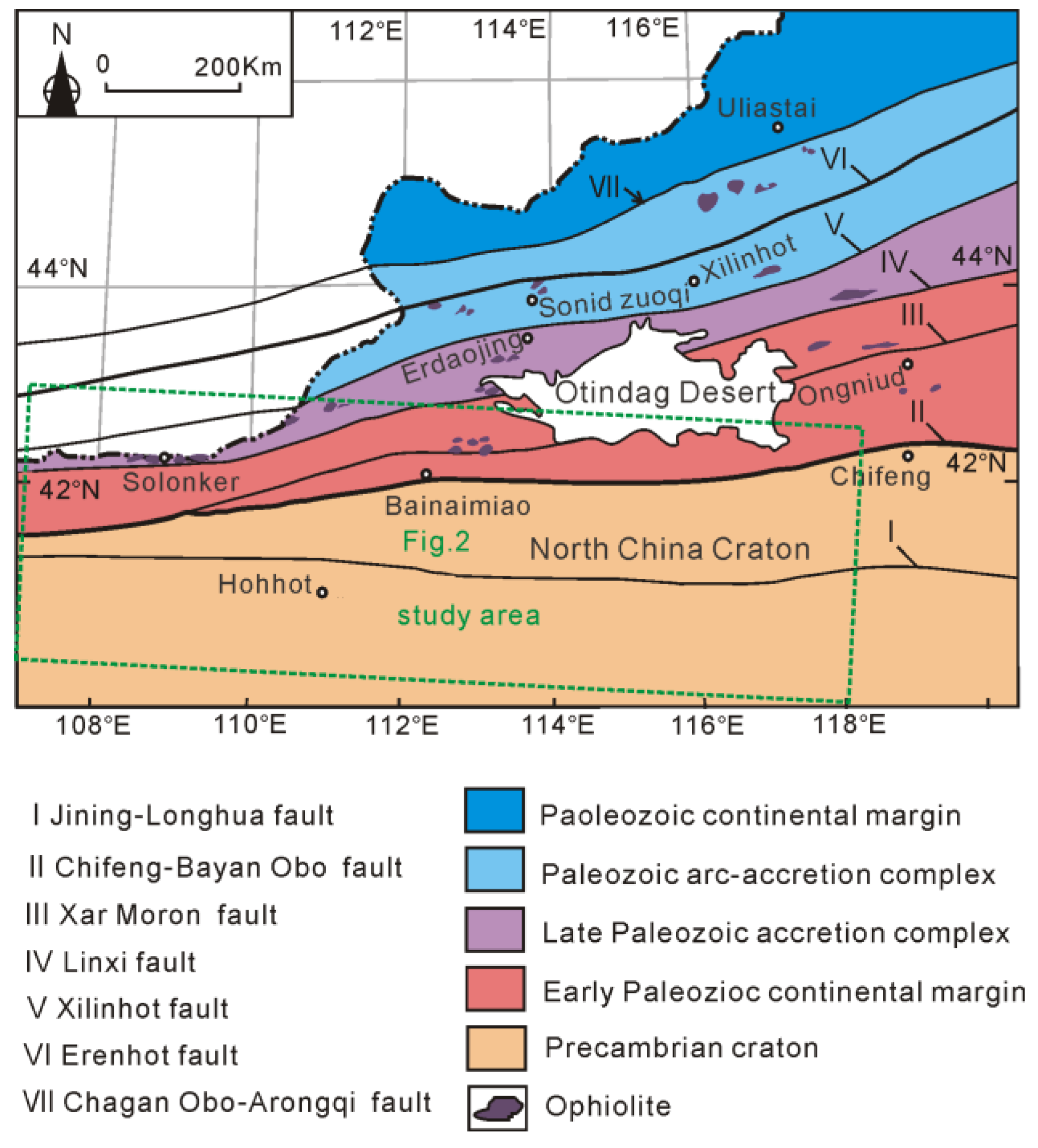

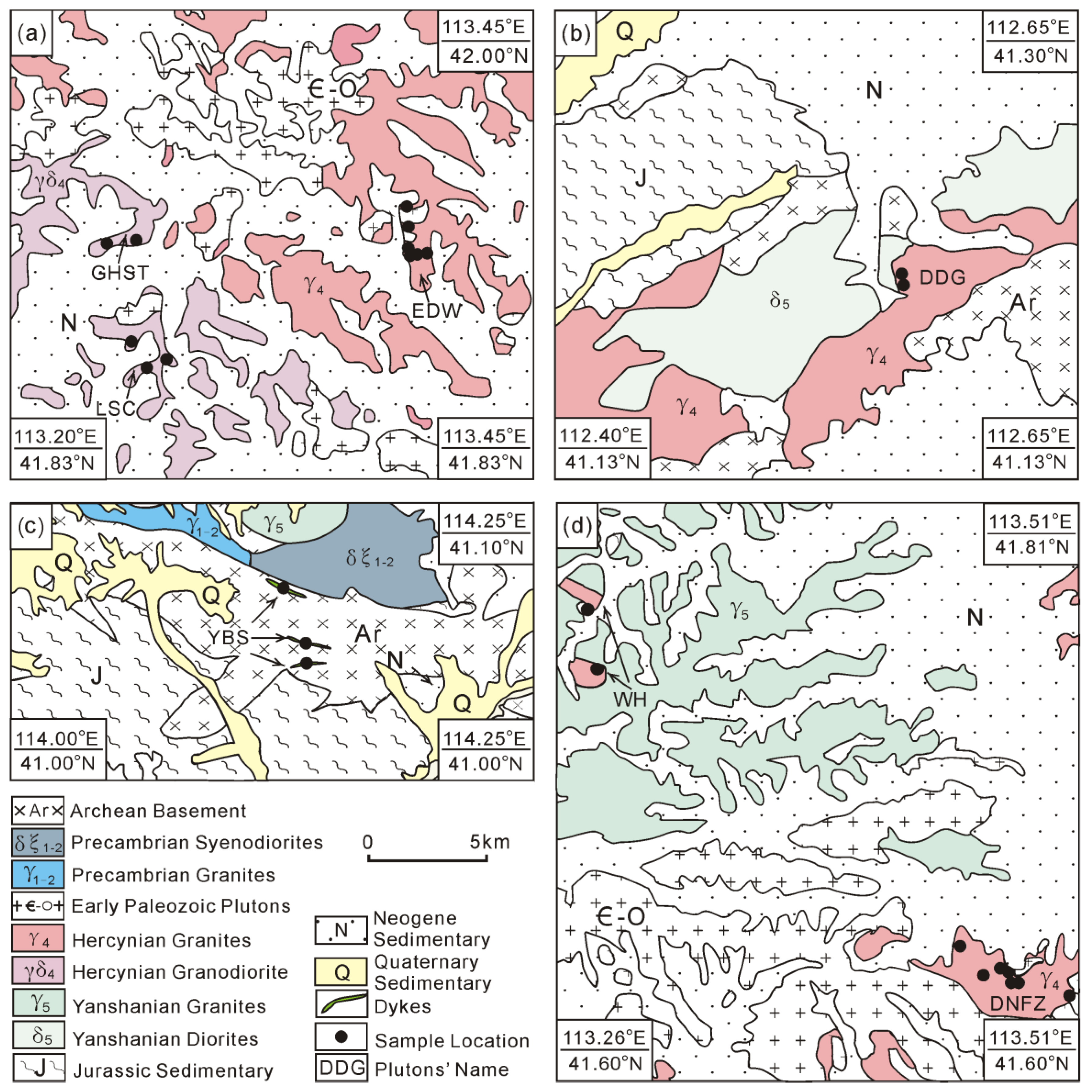
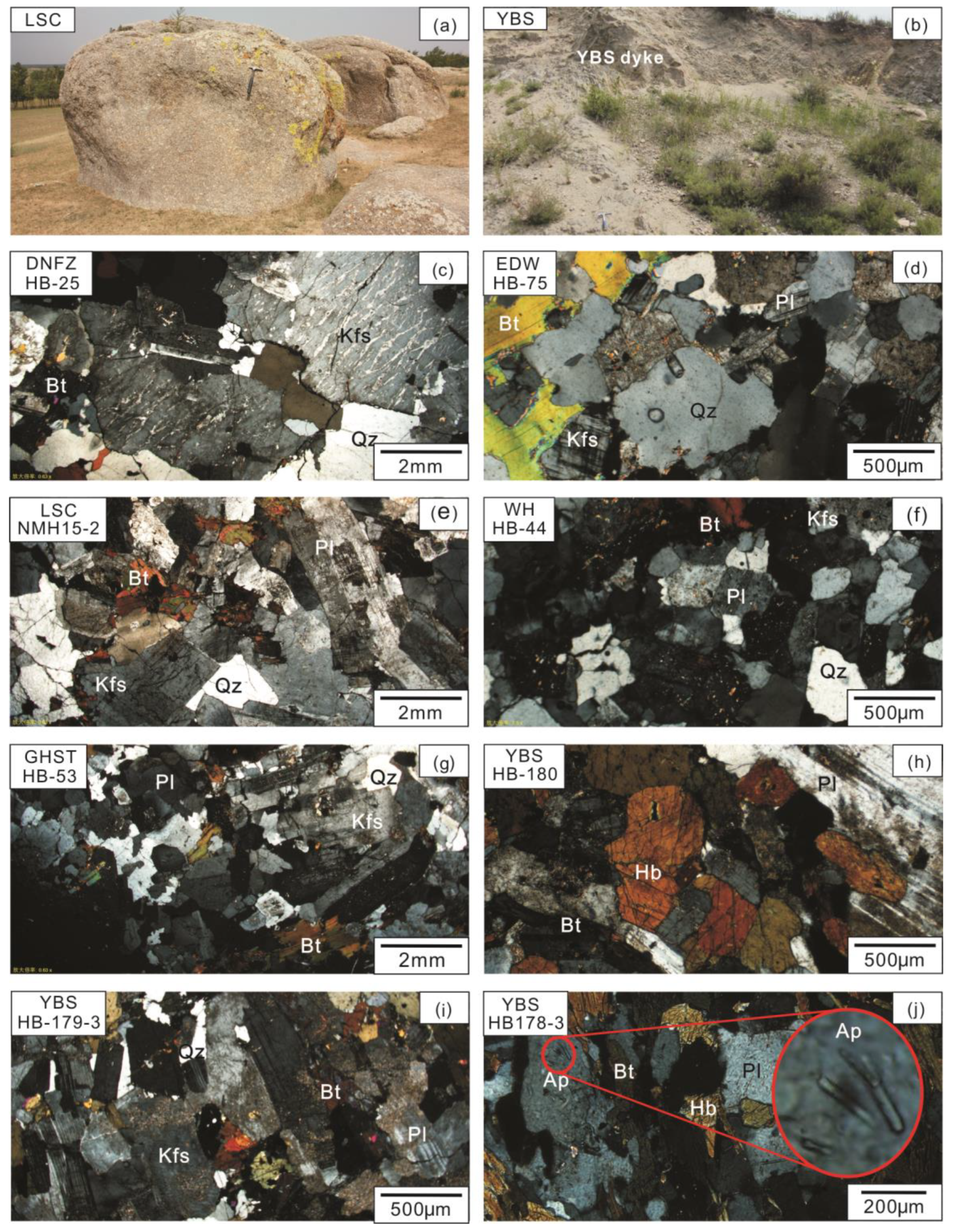

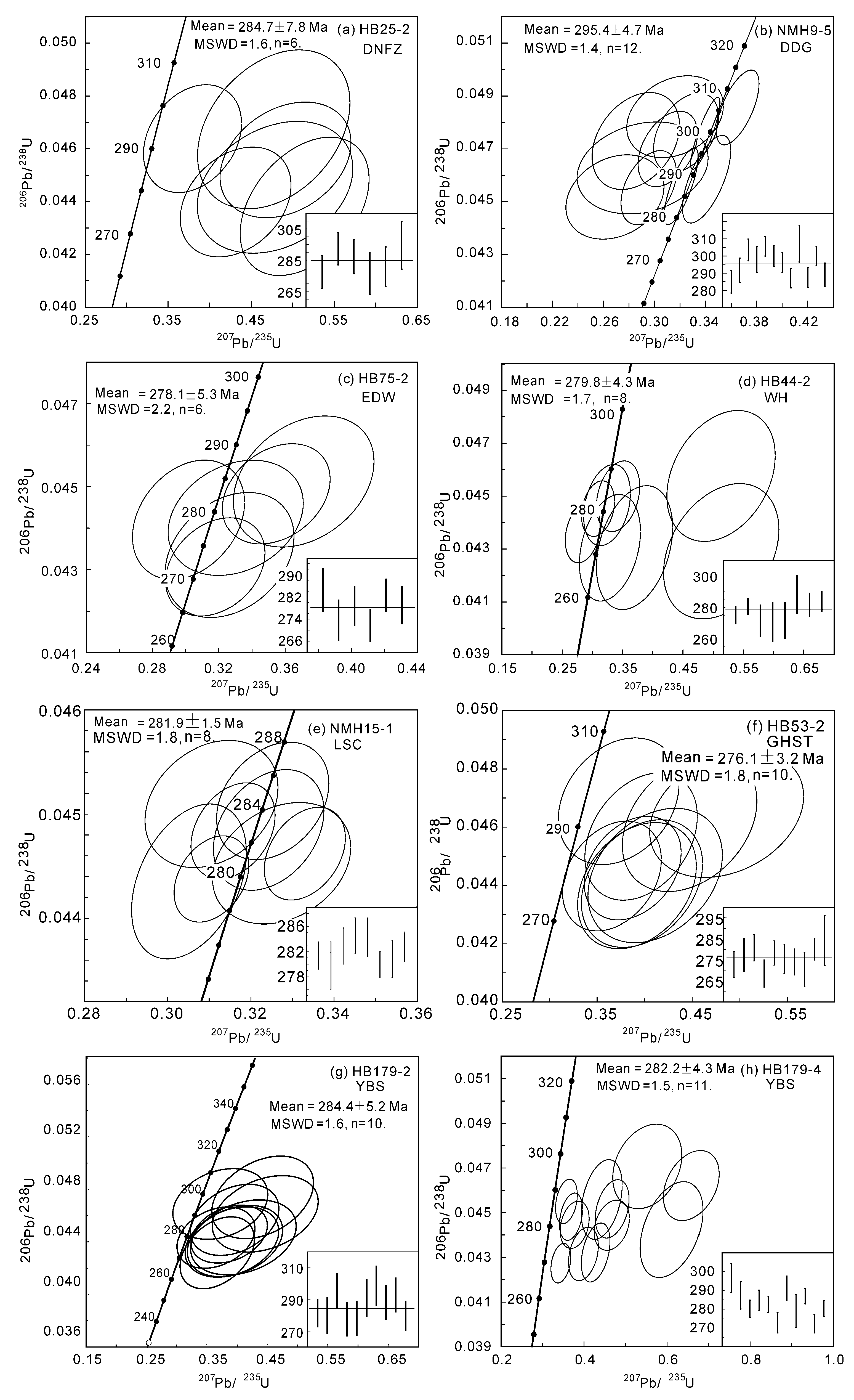

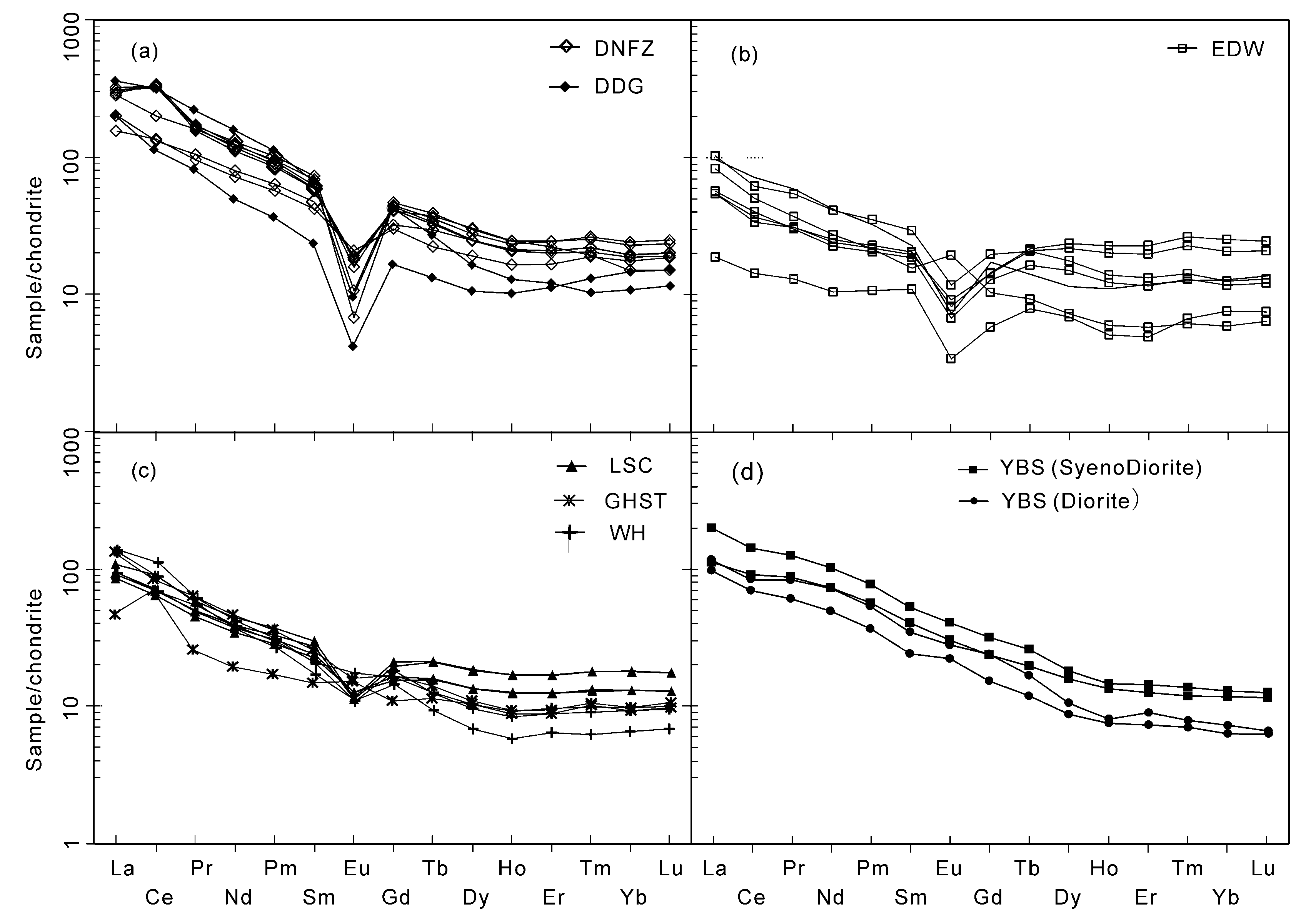

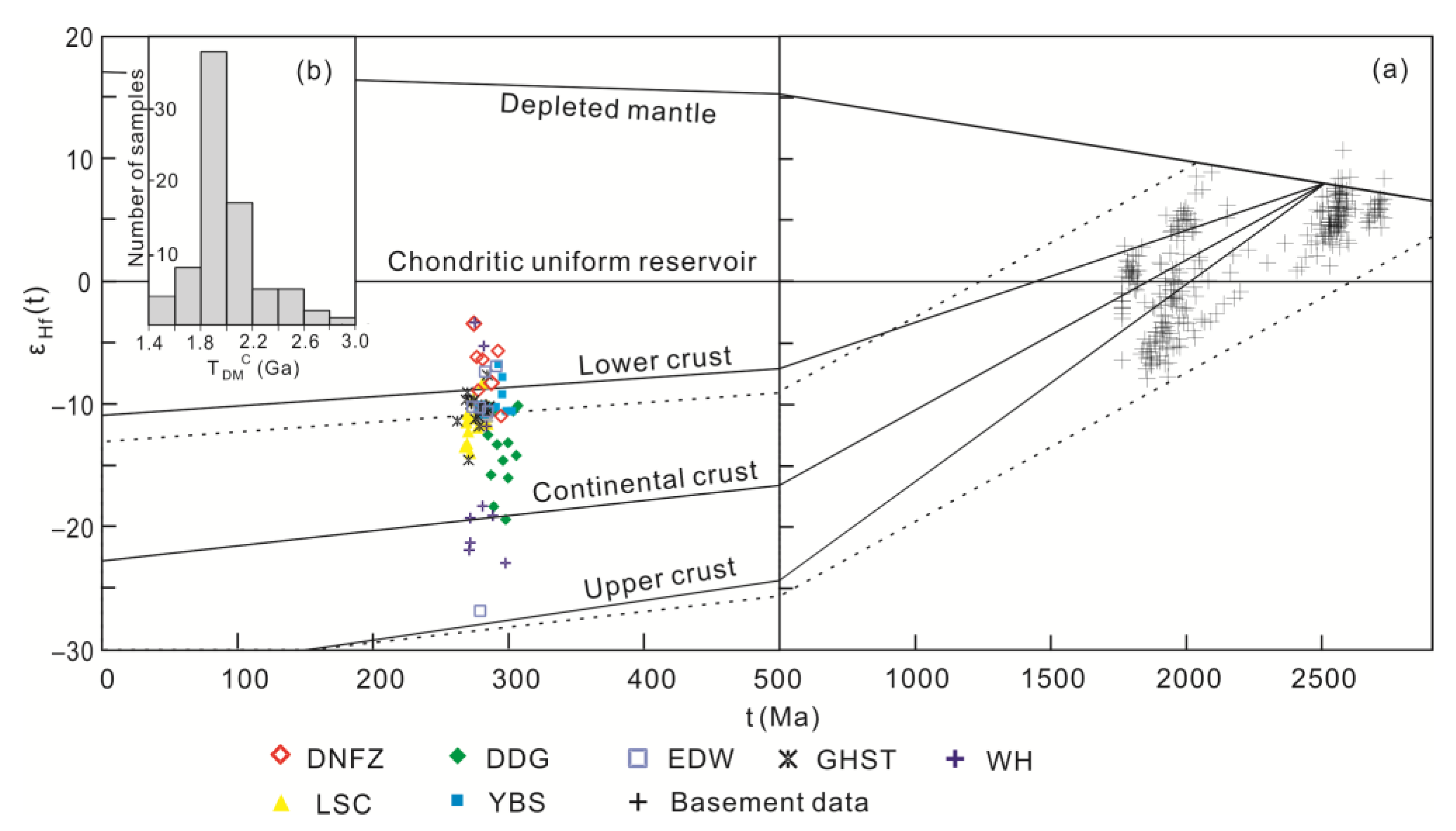
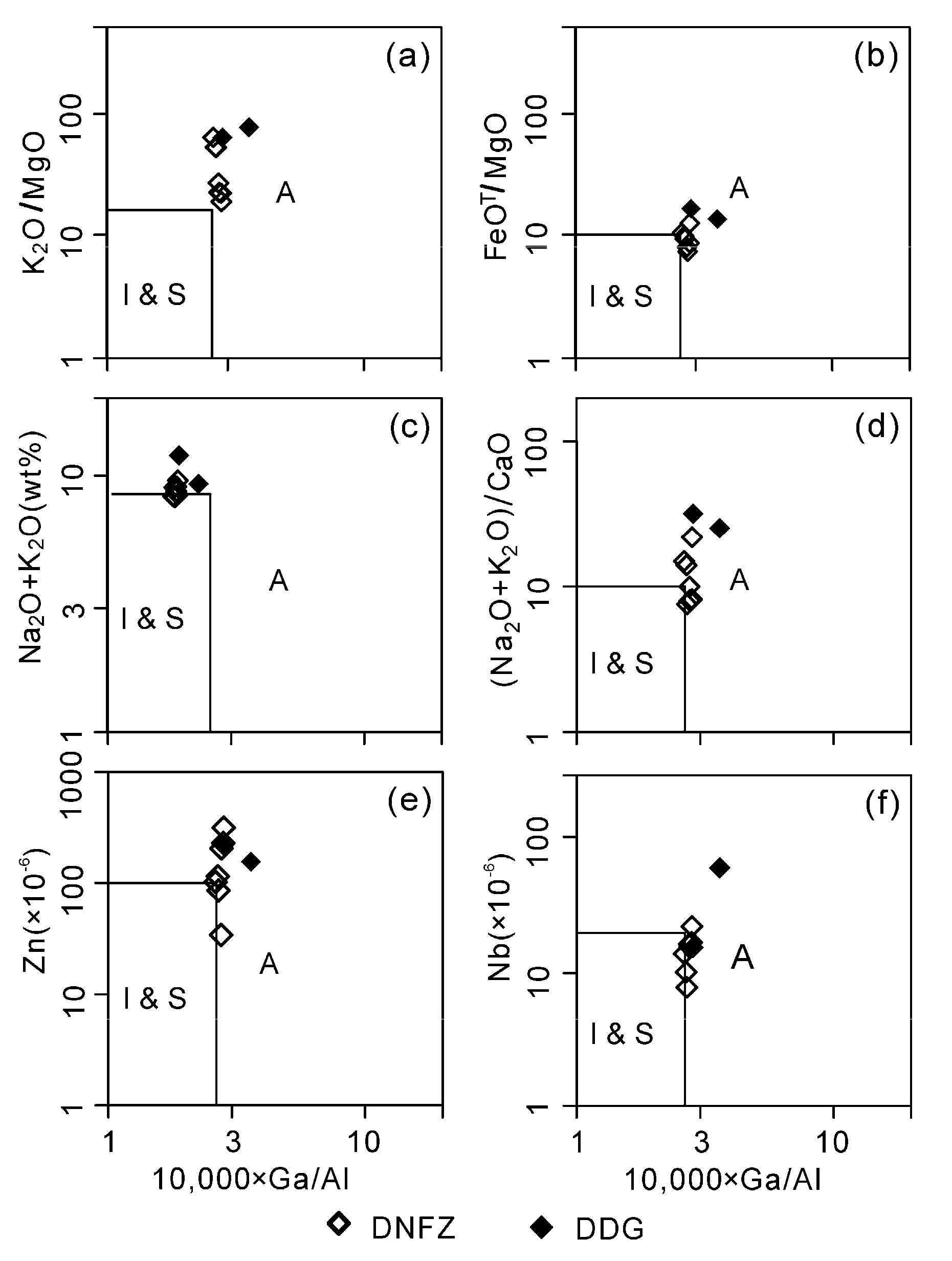


Publisher’s Note: MDPI stays neutral with regard to jurisdictional claims in published maps and institutional affiliations. |
© 2021 by the authors. Licensee MDPI, Basel, Switzerland. This article is an open access article distributed under the terms and conditions of the Creative Commons Attribution (CC BY) license (http://creativecommons.org/licenses/by/4.0/).
Share and Cite
Li, L.; Hou, Q.; Huang, D.; Wang, X. Early Permian Granitic Magmatism in Middle Part of the Northern Margin of the North China Craton: Petrogenesis, Source, and Tectonic Setting. Minerals 2021, 11, 99. https://doi.org/10.3390/min11020099
Li L, Hou Q, Huang D, Wang X. Early Permian Granitic Magmatism in Middle Part of the Northern Margin of the North China Craton: Petrogenesis, Source, and Tectonic Setting. Minerals. 2021; 11(2):99. https://doi.org/10.3390/min11020099
Chicago/Turabian StyleLi, Longxue, Qingye Hou, Dingling Huang, and Xinyu Wang. 2021. "Early Permian Granitic Magmatism in Middle Part of the Northern Margin of the North China Craton: Petrogenesis, Source, and Tectonic Setting" Minerals 11, no. 2: 99. https://doi.org/10.3390/min11020099




